Here we share our own Diwali traditions (foods, foods, an activity and puja sounds), as well as the traditions of other expat friends, to start to paint a picture of the various Diwali traditions as they have evolved outside of India.
story
Diwali Traditions
I have been celebrating Diwali with my husband for many years. My first Diwali in India was in 2008, which was a wonderful experience.
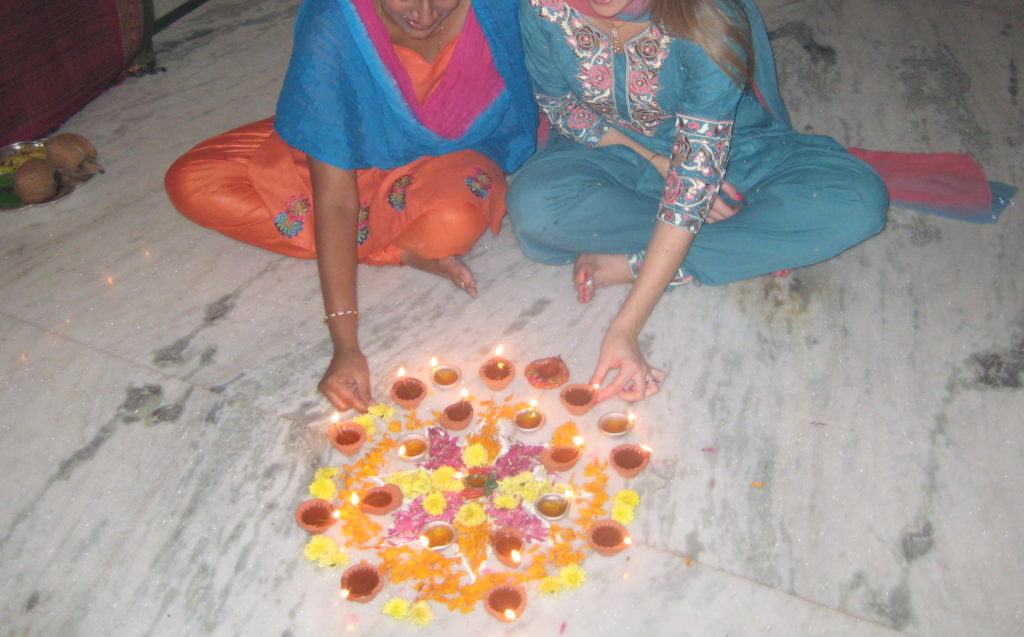
Since having kids, our traditions have grown with them. Some of our traditions grew out of what my husband did in India, but much of it fabricated by me as a way to make things more special when do not have our friends and family all around us.
For example, my husband never painted diyas like we do, but that has become an important part of our Diwali traditions. But we then do puja with those diyas in the same way my husband did growing up, and we eat the same foods as well.
This year I was curious how Diwali traditions had morphed or stayed the test of time for other expats and so I asked several friends to share.
They reflected on Diwalis of their childhood: what they remembered, and what they carry forward for their own families. As expected, there are many similarities but also many unique takes. All beautiful and special.
A look at varied memories and traditions for Diwali
As you probably know, Diwali is the festival of lights. Across geographies, there are variations on the legends behind and traditional rituals of the Diwali festival, but of course there are some similarities as well.
I’ve been in Hyderabad, India for a few Diwali festivals now, and our Brooklyn celebrations are decidedly more low key (read: safer, what with no fireworks bouncing off buildings back at us), but they are fun nonetheless. And they are repeatable!
music
Diwali Puja + Dance Party
Click on over to the Spotify playlist here.
First up: a Lakshmi Stotrum for your puja.
Then comes then many of our all time fave Bollywood dance hits, because no party is complete without a dance party.
story
Diwali Traditions
I was curious about what Diwali traditions looked like for other expats, so I asked several friends about their traditions. Here is what they shared:
Swetha, in Pondicherry, by way of Hyderabad and New Jersey:
“This is what I remember of Diwali growing up:
Since for Diwali we perform goddess Laxmi puja, and it is believed that she visits the houses which are kept clean, the folks actually start cleaning and reorganizing their houses (and shops too) way before the festival. Diyas when lighted in front of the house is supposed to invite the goddess and show her the path to their homes. Folks also purchase gold/ silver around this time.

We also celebrate one day before Diwali as Naraka Chadurdasi. This is the day they say Lord Krishna with the help of his wife Satyabhama killed the demon Narakasura. We actually take head bath on this day as the Diwali day is amavasya (I am not exactly sure of the reasons, but we usually don’t take head baths on amavasya). We used to make some milk based sweet at home and offer it to God this day.
Diwali also marks the start of Karthika maasam in Andhra which is a very auspicious month where many people fast all day performing pooja to Lord Shiva and break the fast only after sunset.
On the day of Diwali, we perform goddess Lakshmi puja in the evening and then light all the diyas and burn the fire crackers. Right after we are done with the fire works, the first thing they say we should eat is a sweet.
When it comes to sweets, I remember in Hyderabad there was one particular sweet that used to be available in sweets shops only around Diwali time – Pheni. This I believe is more from North where Marwadis community has this tradition of eating it around that time. But, all the same, we used to enjoy that very much around Diwali and still do.
When we were growing up, we used to concentrate more on fire works :-). We made small ones with news papers, sand and gun powder. we also used to get lot of hand made local fire crackers – mathabulu, seema tapasulu, sisindhri, ullipayalu (English translation – onions), which we used start burning them way before Diwali 🙂 They were in many ways eco-friendly, known to kill lot of mosquitoes and other flies, unlike the ones that we get now.
Yashoda, in Northern New Jersey (USA):
“Growing up in India, we would always eat lemon rice, tamarind rice and pongal. In Telugu states the primary staple or grain that is readily available is rice. I think that’s why festive special dish is typically a rice dish. I think there is actually some practical reasons behind Diwali fireworks: the fumes typically get rid of mosquitoes which are plenty in this season. Also to cope with changing seasons and rains, celebration helps. What’s better than adding a little twist with “victory of good over evil?”
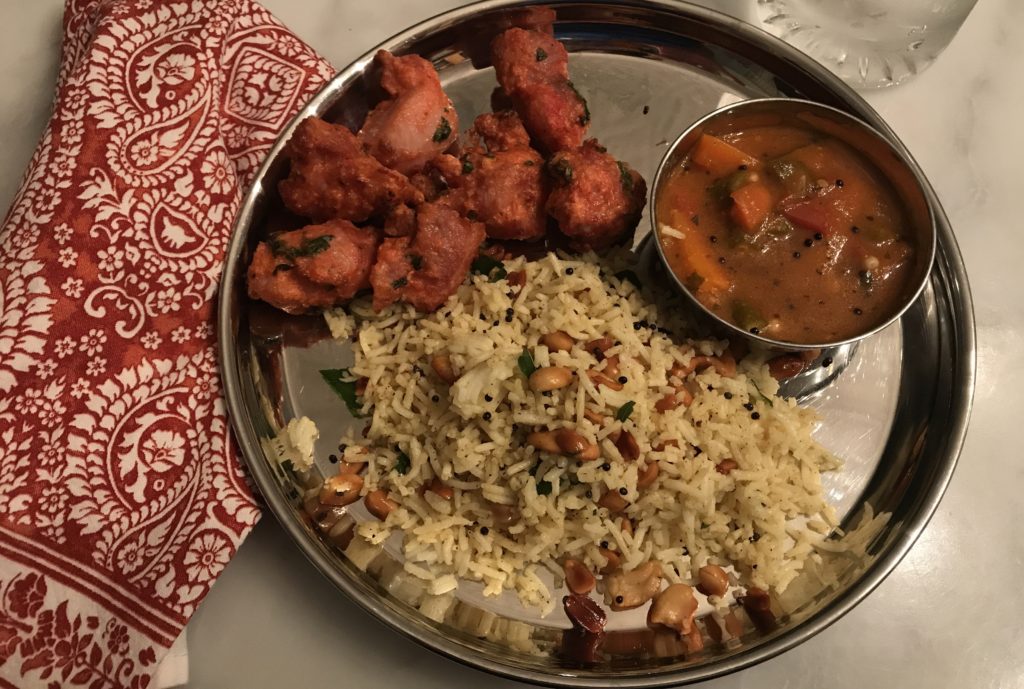
Tina, in Brooklyn, NY (USA):
“I asked my mom and aunts about the roots of our Diwali traditions. They said food should include saag, channa / rice khichdi. We do a prayer, aarti, singing then eat and hang out! People often host lots of parties with card games.”
Meghna, in Brooklyn, NY (USA):
“First we need to clean the house well! We know that Laxshmi will only visit clean homes and we want her to bestow prosperity on hour home.
The other thing we do to prepare is to decorate by painting diyas, and we often like to invite friends to join us for this part. That part is extra special because it is fun to see how our skills and designs change as a family over the years.
Then when Diwali begins, we do puja, eat good food, light sparklers if we have them, and a requisite, dance party,”

recipe
Menu Plan
As usual, we asked nani what she’d be preparing, and she told us “lemon rice, pongal, vada and kheer.”
We wanted to replicate but we were fresh out of vada ingredients so we made Chicken 65 for a different fried favorite.
Somehow I’d never made Lemon Rice, so that was a definite. Generally, we are not huge fans of kheer but I thought it would be fun to try a version using shredded apple (to use some of the abundance from the yearly apple picking excursion, and a fun way to tie that tradition with Diwali) rather than vermicelli. It was great.
Finally, we made our favotite sambhar to round out the chicken and rice,and skipped pongal because no one’s a big fan. (Yes, I know that part of the reason for making Pongal is prasadam, but we offered kheer instead).
Overall game plan: If you have time to make the sambhar ahead and let it sit, do that.
If you are tight on time: prepare chicken to let it marinate for a bit, get rice cooking in the rice cooker to later become lemon rice, and then work on sambhar. When sambhar is thickening and melding, quickly make kheer and let it sit until dessert time. Then again, if you have time to make the sambhar the day before or pull it out of the freezer from the last big batch, is even better.
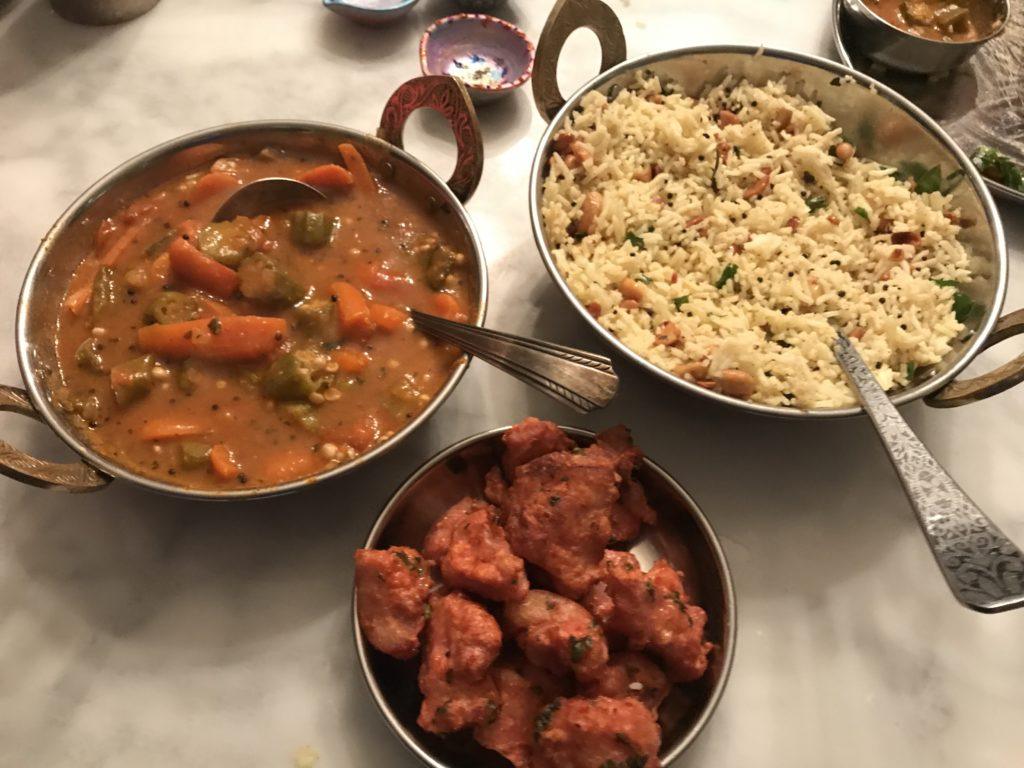
recipe
Chicken 65
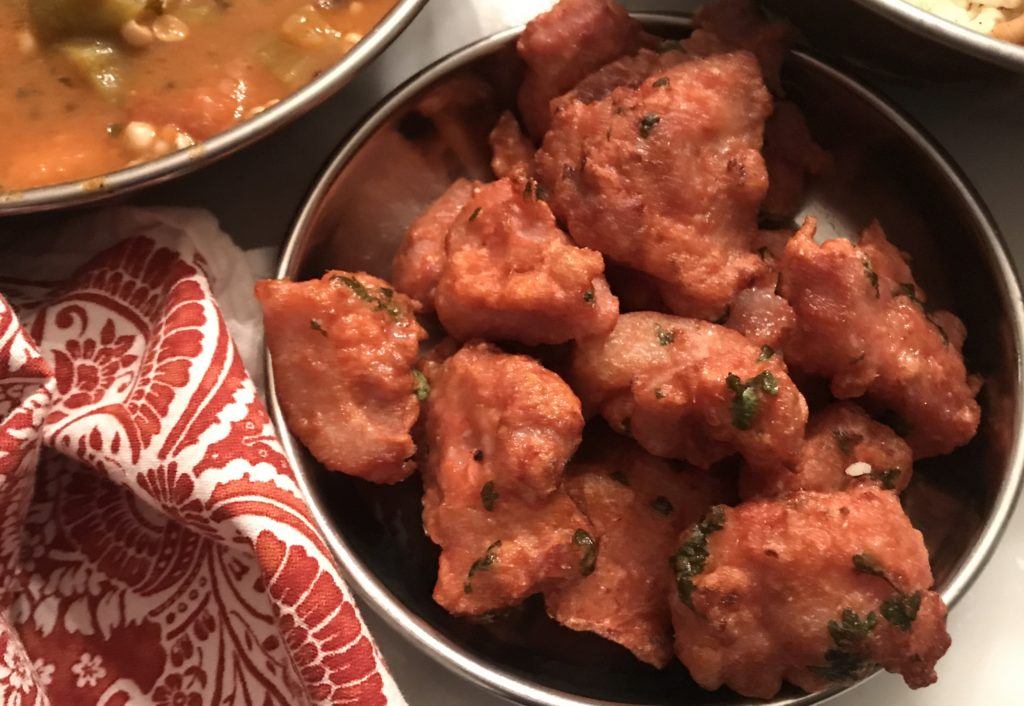
Chicken 65
Ingredients
- 2 tbsp fresh lemon juice
- 1/2 cup cilantro leaves, chopped very small and loosely packed
- 2 1/2 tbsp ginger-garlic paste
- 2 egg whites
- 4 drops of red food coloring
- 2 tsp salt
- 1/4 tsp chili powder (more to taste / depending on strength!)
- 1 small green chili, diced small (optional but so delicious)
- 1 1/2 lbs chicken thigh, chopped into 1 inch pieces
- 5 tbsp corn starch
- vegetable oil for frying (amount depends on size of your pan)
Instructions
- Prep for marinade: juice the lemon(s); clean and chop cilantro & chicken, and make ginger garlic paste, if you don’t have it on hand.
- In a large bowl, whisk egg whites to combine a bit.
- Add ginger-garlic paste, food coloring, cilantro, lemon juice, salt and chili powder and whisk until combined. Keep aside.
- Clean and chop chicken and add it to the marinade, while stirring to coat the chicken. Marinate for 30 minutes in the fridge if you have time, but really, it’s not that necessary.
- Add the corn starch when you’re ready to cook. This should thicken things up enough that the chicken is coated a bit and nothing drips off to be left in the bowl.
- Heat the oil on medium-high heat. When the oil is hot, add 2 pieces of chicken (start with that to test taste and consistency). Ensure the pieces don’t stick to each other and turn them, if necessary. They will begin to turn a bit darker in color when cooked. Cut it to confirm it is cooked all the way through. Allow them to cool on a paper towel for a moment to absorb any excess oil.
- Adjust accordingly and continue in small batches, per the size of your pan.
recipe
Souped-up Sambhar

Souped-up Sambhar
Ingredients
- 1/2 – 3/4 lb of carrots sliced into 2 inch x 1/4 inch sticks
- 1 package of Gits Sambhar Mix* (a great base! Highly recommend, but I prepared with the below adjustments to take it to the next level)
- 2 large tomatoes, diced
- 1 lb okra, tips removed and sliced into 1/2 inch rounds (frozen chopped okra works well, too)
- 4 tbsp buffalo ghee
- 2 whole red chilis, but tops popped to removed as many seeds as possible
- 2 tsp mustard seeds
Instructions
- Heat 4 1/4 cups of water in large saucepan. When boiling add carrots and cook until just tender.
- Add Gits mix and stir ensuring all is dissolved.
- Add chopped tomatoes and cook until they begin to break down.
- Add okra and cook until okra just becomes soft (5-10 mins)
- Heat a small fry pan. When hot, add the ghee, moving the pan to melt it.
- Add the red chilis and mustard seeds, continuing to shake the pan so that nothing burns.
- When the seeds begin to pop, turn off the heat and add the tempered ghee to the sambhar mixture (careful! It will sputter!)
- Cook for a few mins longer.
Notes
We prefer our sambhar a bit thicker than you may find in restaurants or even on tables in India. Somewhere in between soup and chili. Perhaps the consistency of melted ice cream? Try it!
Adapted from Sanjay Kapoor’s online version *Find Gits Sambhar Mix here
recipe
Lemon Rice
We simply followed the Veg Recipes of India recipe for Lemon Rice.
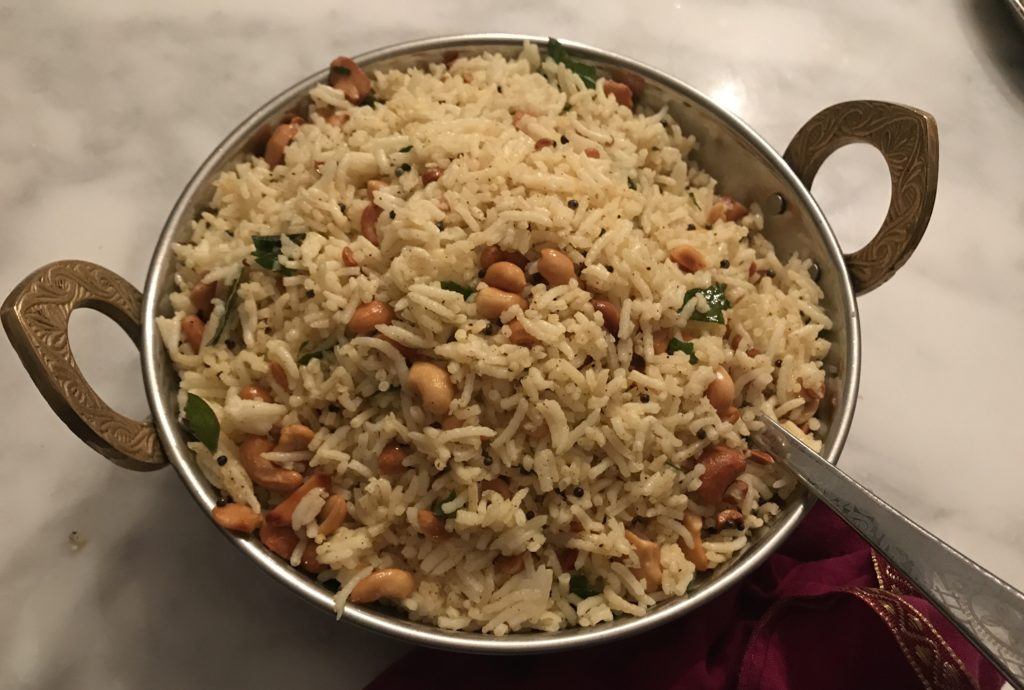
recipe
Apple Kheer
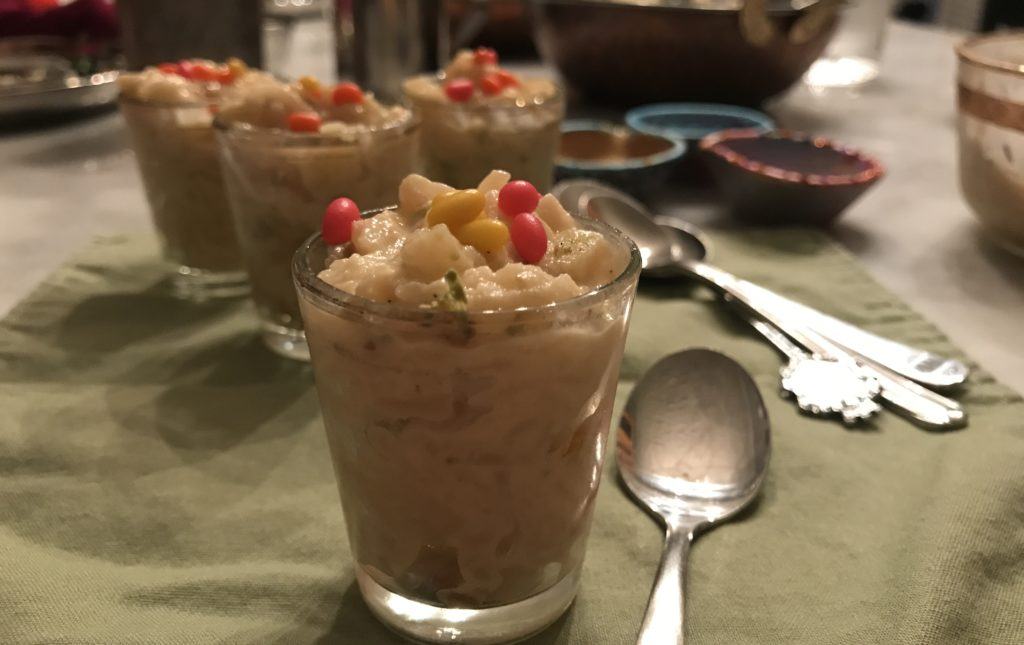
Apple Kheer
Ingredients
- 6 smallish apples (by US standards at least, we used Empire apples this time)
- 1/3 cup slivered almonds
- 1 can evaporated milk
- 3/4 cup sugar
- 15 pistachios
- 1/2 tsp cardamom powder (more to taste)
- dash of salt
- optional garnishes: saunf*, additional cardamom powder, raisins, almond slivers
Instructions
- Peel and grate apples.
- Cook in a sauce pan over medium heat, stirring constantly, allowing some of the moisture to evaporate.
- After 5 minutes, add almonds and cook for at least another 5 mins, when the moisture should be nearly gone.
- Add evaporated milk, sugar, pistachios, cardamom powder and salt and increase heat slightly until it nearly boils, then reduce it to medium low to simmer gently.
- After about 8 minutes, when desired consistency is reached, turn off the heat and let it cool. You may even want to chill it before serving it.
- Serve in individual small bowls/glasses, or in a serving bowl. Garnish as desired.
Notes
Adapted from Sanjeev Kapoor’s online version * You can find saunf here
Bonus
Paint Some Diyas!
One of our Diwali traditions includes painting our own diyas . We now have quite a collection, and not unlike homemade ornaments on our Christmas tree, part of the fun at Diwali each year is looking at designs of past years, particularly as the kids age.
The diyas we paint are intended for oil or ghee and a cotton wick, but we usually just use tealights instead so as not to disturb the design when we want to light them.
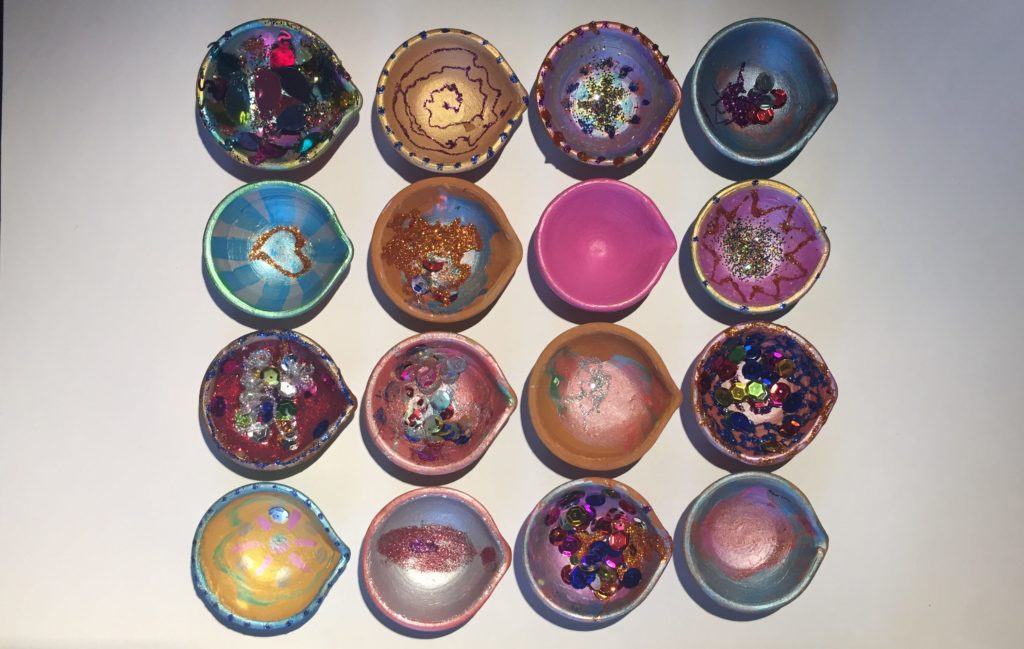
Of course, even if you don’t plan on using them for a puja, they are beautiful. I even have one above my desk, and we keep a rotating few on our home altar as well.
Depending on your paint and decorations, make sure to leave some time for these to try before you need them for your puja.
Supplies
- Diyas – This is the style we use each year, but they are probably less expensive if you have a Indian store close by. In those stores you may even find varied sizes and more intricate designs like this one, but unpainted.
- Paints – We’ve tried both acrylic paints and tempera paints. The tempera we had was sparkly so the kids tended toward that, but it also was absorbed byt he terracotta and required several coats.
- Glitter Glue / Puffy Paint: is a nice way to embellish but not necessary. Only if its fast-drying!
- Sequins, confetti, glitter – use only if you have quick drying glue, or you will be inviting tears from your little artists.
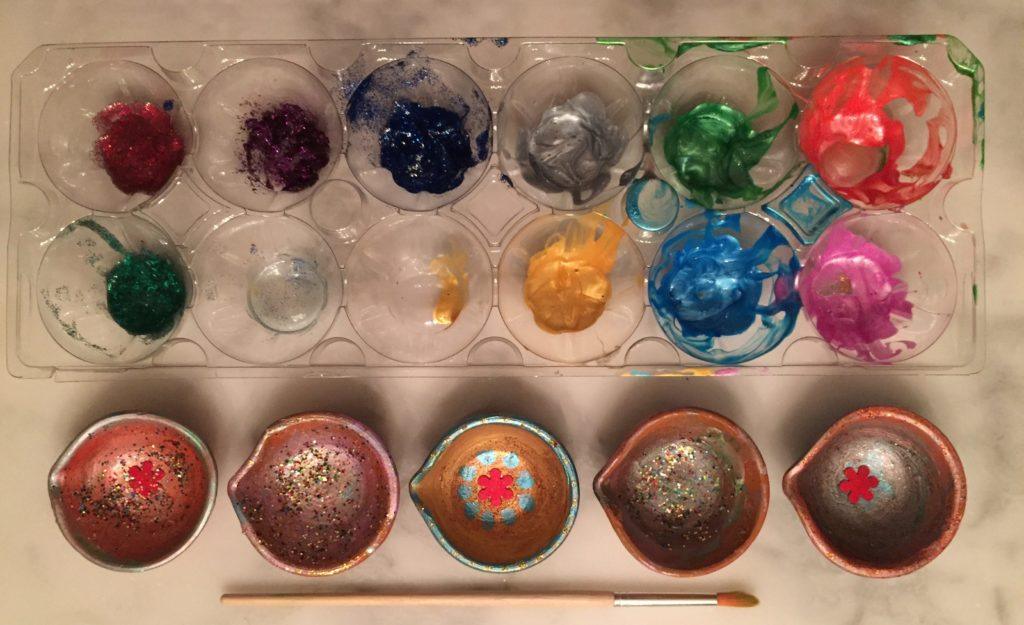
Steps
- Cover your surface for easier clean-up later.
- Wipe off diyas with damp cloth to get off any dust.
- Gather paints, paintbrushes and any other embelishments.
- Squeeze a bit of paint into egg carton sections for easy reach and cleanup.
- Plan to put a few base coats as the terracotta is thirsty and will absorb the paint pretty quickly.
